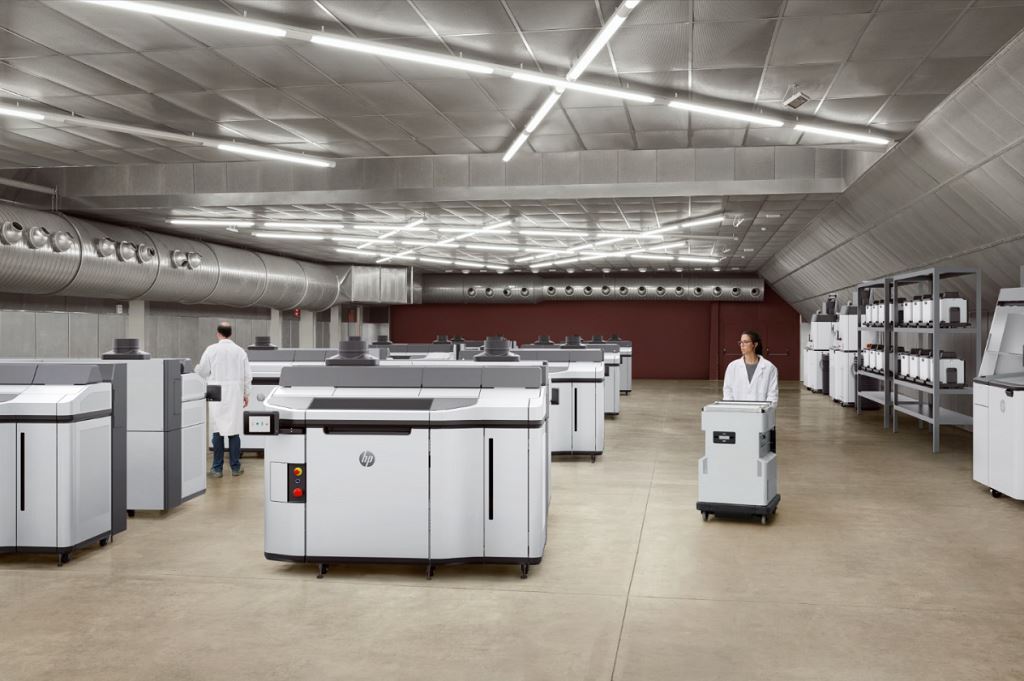![An industrial installation of Jet Fusion 5200 3D printing systems [Image: HP Inc.]](https://fabbaloo.com/wp-content/uploads/2020/05/HPJetFusion52003Dprintingsolution1_img_5eb097e51ebe2.jpg)
HP has a flurry of announcements today focusing on digital manufacturing solutions, including the latest MJF 3D printer.
When HP announced its intent several years ago to enter the 3D printing industry, it was big news. The company is a global giant, and its participation in this segment proved interesting from a business standpoint as a new industrial competitor — and as validation that such a well-known name saw additive manufacturing as a viable area to invest resources.
In 2016, the company introduced Multi Jet Fusion, its 3D printing technology, with the first Jet Fusion 3D printers, the 3200 and 4200 Series. These systems are designed for short-run production. Early last year, the 500/300 Series of color-capable machines targeted at prototyping arrived. Only a few months later, HP turned its sights to metal, introducing Metal Jet technology.
Focus is on MJF today, as the market has thoroughly embraced the technology — to the tune of more than 10 million MJF 3D printed parts last year alone. So now we’re looking ahead at what’s next for Multi Jet Fusion and, broadly, for digital manufacturing.
In a virtual press briefing yesterday, Ramon Pastor, GM and Global Head of Plastics Solutions, HP 3D Printing & Digital Manufacturing discussed HP’s latest work in 3D printing and digital manufacturing. The announcements, Pastor explained, are four-fold:
-
New advanced industrial system, HP Jet Fusion 5200 Series
-
New TPU material to enable new applications
-
Expanded industrial partnerships
-
New HP Digital Manufacturing Network
Jet Fusion 5200 Series, TPU, Software
Starting with the hardware, the 5200 Series is designed to be an end-to-end industrial solution for 3D printing — at volume.
MJF gets a boost in this new system, with particular focus on manufacturing predictability, efficiency, repeatability, and injection molding-comparable quality.
“The new HP Jet Fusion 5200 Series 3D printing solution brings together new systems, data intelligence, software, services, and materials innovations enabling customers to scale their 3D production and target business growth. Leveraging these innovations, the new solution expands manufacturing predictability with high-quality and optimal-yield of parts at industrial levels of efficiency, accuracy, and repeatability,” Pastor said during the briefing.
The new introductions to HP’s 3D printing solutions portfolio are built on customer feedback. The main drivers that production users indicated they needed included:
-
Lower production and running costs
-
Superior accuracy and consistency to drive manufacturing productivity
-
Ability to expand applications through more materials and options
Pastor said that with the 5200 Series’ improvements, productivity is enhanced by up to 40% with an up to 30% reduction in running costs.
Also new is the widening of material capabilities and new software suites.
HP is introducing flexible capabilities with Ultrasint 3D TPU01 from BASF.
The new material is already seeing a pretty wide variety of uses; Pastor highlighted applications with Vestas to protect wind turbine blades from scratches, with Kupol to create better helmets, and within HP itself for a code wheel cover for Textile and Large Format printers, where the flexibility is especially suited for parts that require frequent assembly and disassembly.
New software suites are HP 3D Process Control and HP 3D Center.
Focuses went along with the production capabilities of the 5200 Series to improve uptime, streamline workflows, and simplify fleet management required for factory production environments. The software builds in new data intelligence and machine learning capabilities.
Systems are already in place with early users, including Avid Product Development, BASF, Jaguar Land Rover, Kupol, Materialise, Sculpteo, Prodartis, and Vestas.
Deepening Industrial Alliances
HP’s participation in the 3D printing industry has been built from the start with strong partnerships — and these are now expanding.
In focus are relationships with three key partners: Siemens, BASF, and Materialise.
With Siemens, HP is deepening the alliance to integrate their 3D printing and data intelligence platform with Siemens’ Digital Enterprise software portfolio. This of course includes the new Jet Fusion 5200 Series. The companies will be developing a joint additive manufacturing solution focused on automotive and industrial applications, as well as digital factory development.
With BASF, the focus is of course on materials development. In addition to the new TPU material, the companies will work toward joint applications development. The two are already working with the likes of Vestas and Sculpteo toward new applications for the Ultrasint TPU.
Materialise and HP will work together toward workflow integration, joint applications development, and in the new HP Digital Manufacturing Network. The companies are integrating both the 5200 Series and the 500/300 Series with Materialise’s Build Processor and Materialise Magics. Materialise itself is also an early 5200 customer.
HP Digital Manufacturing Network
Finally, HP is launching its Digital Manufacturing Network.
The company has been betting on industrial 3D printing since it first tested the waters of this industry, and this move is another strong statement toward the validation of additive manufacturing in the global manufacturing industry.
Again focused on work with a strong team of partners, the new network is “a global community of HP production partners to help design, produce, and deliver both plastic and metal parts at scale leveraging HP 3D printing solutions.”
In addition to Materialise, initial production partners include Forecast 3D, GKN Powder Metallurgy, GoProto, Jabil, Parmatech, and ZiggZagg.
Many of these names are familiar as long-time HP partners, so there’s not much surprise among them that they’ve each met “HP’s stringent program qualifications” to take their place in the worldwide network.
While the network cur
rently has partners in the US, Europe, and Asia, HP is keen to see it expand “in the coming months.”
We’ll have a closer look at the Jet Fusion 5200 Series soon, and will continue to ruminate on the implications of all of these announcements.
Via HP











The debate over use of proprietary or open materials ecosystems is becoming a big topic in 3D printing.